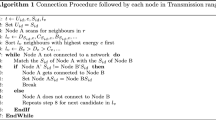Abstract
Mobile Ad-Hoc networks are built spontaneously from mobile devices communicating via wireless interfaces. The idea is that some of the devices act as relay stations in such a way that two stations, which are not in direct range, can communicate with each other over this new multi-hop connection. However, the nature of Ad-Hoc networks and especially the mobility of nodes makes it difficult to achieve a certain minimum connectivity, which is an indispensable property for reliable communication. With our simulation tool ANSim (Ad-Hoc Network Simulator), we have already shown that with randomly moving nodes (a realistic assumption) one needs many mobile devices to achieve an acceptable connectivity. In this paper, we therefore investigate the idea of introducing mobile robots to such a network, whose only function is to act as a relay station thus not to fulfil any application-specific task. The robots have to find out the optimal position in the network, i.e., the place where they can best support application-oriented devices in their work. In this first approach we assume that the robots have full knowledge of the positions of all other devices. We simulate their behaviour in this situation. The results indicate that further work on this idea will be worthwhile.
Access this chapter
Tax calculation will be finalised at checkout
Purchases are for personal use only
Preview
Unable to display preview. Download preview PDF.
Similar content being viewed by others
References
E. Dijkstra. A note on two problems in connection with graphs, 1959.
T.D. Dyer and R.V. Boppana. A comparison of tcp performance over three routing protocols for mobile ad hoc networks. ACM Mobihoc, October 2001.
M. Grossglauser and D. Tse. Mobility increases the capacity of ad-hoc wireless networks. IEEE INFOCOM, April 2001.
P. Gupta. Design and Performance Analysis of Wireless Networks. PhD thesis, Coordinated Science Labatory, University of Illinois, 2000.
Horst Hellbrück and Stefan Fischer. Basic analysis and simulation of ad-hoc networks. Technical Report TR01, International University Bruchsal, December 2000.
Horst Hellbrück and Stefan Fischer. Towards analysis and simulation of ad-hoc networks. In Proceedings of the 2002 International Conference on Wireless Networks (ICWN02), pages 69–75, Las Vegas, Nevada, USA, June 2002.
Kannan Varadhan Kevin Fall. The ns Manual The VINT Project—a collaboration between researchers, 1989-2001.
Jinyang Li, Charles Blake, Douglas S. J. De Couto, Hu Imm Lee, and Robert Morris. Capacity of ad hoc wireless networks. In Proceedings of the 1th ACM International Conference on Mobile Computing and Networking, pages 61–69, Rome, Italy, July 2001.
Elizabeth M. Royer and Charles E. Perkins. Transmission range effects on aodv multicast communication. Swedish Workshop on wireless Ad-Hoc Networks, March 2001.
J. Macker S. Corson. Routing protocol performance issues and evaulatin considerations. Technical Report RFC2501, MANET Working Group, January 1999.
S. Toumpis and A. Goldsmith. Capacity regions for wireless ad hoc networks. IEEE Transactions on Wireless Communications, Sept. 2001.
Author information
Authors and Affiliations
Editor information
Editors and Affiliations
Rights and permissions
Copyright information
© 2003 Springer-Verlag Berlin Heidelberg
About this paper
Cite this paper
Hellbrück, H., Fischer, S. (2003). Increasing Connectivity of Ad-Hoc Networks. In: Irmscher, K., Fähnrich, KP. (eds) Kommunikation in Verteilten Systemen (KiVS). Informatik aktuell. Springer, Berlin, Heidelberg. https://doi.org/10.1007/978-3-642-55569-5_17
Download citation
DOI: https://doi.org/10.1007/978-3-642-55569-5_17
Publisher Name: Springer, Berlin, Heidelberg
Print ISBN: 978-3-540-00365-6
Online ISBN: 978-3-642-55569-5
eBook Packages: Springer Book Archive




